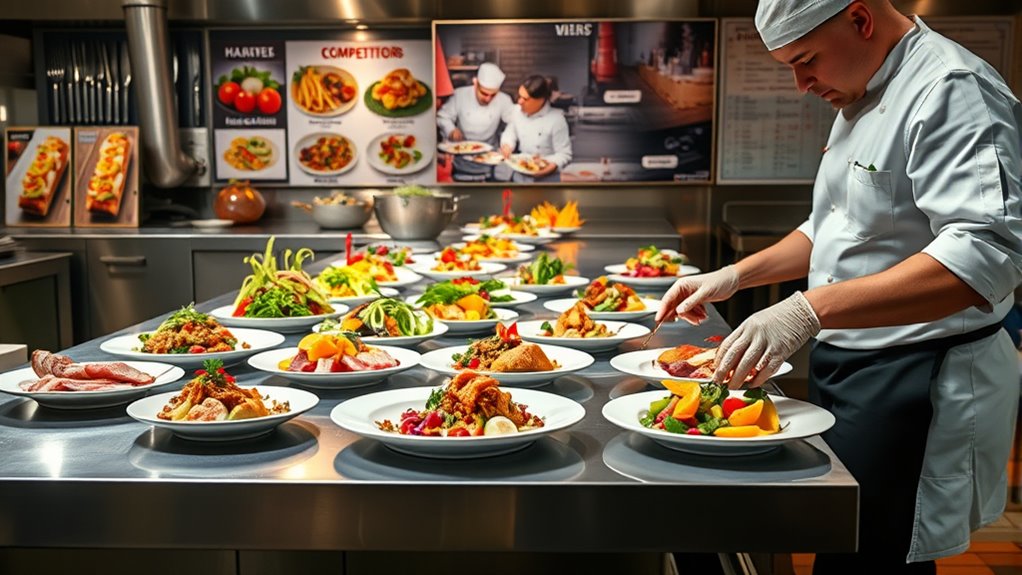To analyze competitors and make your menu stand out, start by identifying their strengths, weaknesses, and pricing strategies. Pay attention to customer reviews and preferences to find gaps you can fill with unique, high-quality options. Focus on differentiation by offering specialty dishes, dietary choices, or a memorable experience. Continuously monitor market trends to stay ahead and refine your approach. Keep exploring these tactics to discover even more ways to attract and delight your target audience.
Key Takeaways
- Conduct thorough competitor analysis to identify their strengths, weaknesses, and market positioning.
- Study customer reviews and social media feedback to uncover preferences and unmet needs.
- Develop a unique menu by incorporating specialty ingredients, dietary options, or innovative presentation.
- Adjust pricing strategies based on competitor positioning to attract target customer segments.
- Continuously monitor market trends and competitors to refine your menu and maintain differentiation.

To stand out in a competitive food industry, you need to understand what your rivals are offering and identify ways to make your menu unique. Analyzing competitors helps you see where their strengths lie and reveals gaps or opportunities you can exploit. Start by examining their pricing strategies—are they positioning themselves as budget-friendly, mid-range, or premium? Knowing this allows you to tailor your own pricing to attract your target customers effectively. If competitors are focusing on affordable meals, perhaps you can differentiate by offering higher-quality ingredients or specialty dishes that justify a premium price. Conversely, if the market is saturated with cheap options, a well-structured pricing strategy for upscale items can set you apart and attract a different customer segment.
Analyzing competitors’ pricing strategies helps you position your menu effectively and attract your target customers.
Equally important is understanding customer preferences. Pay attention to what your competitors are serving and how their customers respond. Are customers raving about certain dishes, or are there complaints about limited variety? Customer reviews, social media comments, and direct feedback are goldmines of information. They reveal not just what people want but also what they dislike or wish was different. Use this insight to craft a menu that aligns with what your target audience prefers while adding your unique twist. For example, if customers show a preference for healthy, organic options, you can incorporate those into your menu, highlighting local or sustainable ingredients to appeal to their values.
When analyzing competitors, don’t just copy their offerings—think critically about how you can differentiate. For instance, if a rival focuses on traditional pizza, you might introduce gourmet toppings or gluten-free crusts to stand out. If another emphasizes quick service, you could prioritize a relaxed dining experience with exceptional presentation. Incorporating cookie categories and customer preferences into your decision-making can help you create a menu that resonates emotionally and practically. This personalized approach strengthens your brand and fosters loyalty.
Finally, keep in mind that markets evolve, and so do customer preferences. Regularly revisit your competitor analysis to stay ahead. Track how their pricing strategies change and what new trends emerge in customer tastes. Use this ongoing intelligence to refine your menu, ensuring it remains unique and aligned with what your target audience desires. By understanding your competitors and listening to customer preferences, you can develop a menu that not only stands out but also builds a loyal customer base, giving you a sustainable edge in a crowded marketplace.
Frequently Asked Questions
How Do I Identify My Main Competitors Effectively?
To identify your main competitors effectively, start by analyzing businesses with similar market positioning and customer targeting. Look for restaurants or cafes that serve the same cuisine, price range, and attract your target audience. Visit their locations, review their menus, and observe their marketing strategies. This helps you understand their strengths and weaknesses, allowing you to differentiate your offerings and better meet your customers’ needs.
What Tools Can I Use to Analyze Competitors’ Menus?
You can use tools like Yelp, Google Reviews, and restaurant review websites to analyze competitors’ menus, focusing on menu pricing and ingredient sourcing. Additionally, visit their websites or social media pages to see detailed menus and specials. Employ menu analysis software like MenuCover or Upserve, which help compare pricing strategies and ingredient quality. These tools give you insights into how competitors price dishes and source ingredients, helping you refine your own menu.
How Can I Incorporate Local Trends Into My Menu?
Tap into trends by tailoring your menu to local ingredients and seasonal selections. You can track local food festivals, farmers’ markets, and community events to spot popular flavors and fresh finds. Incorporate trending tastes by offering seasonal specials that highlight local produce, giving diners a delightful, dynamic experience. This approach not only attracts trend-conscious customers but also demonstrates your commitment to supporting local suppliers and sustainability.
What Legal Considerations Are Involved in Menu Differentiation?
When differentiating your menu, you must consider legal issues like trademark concerns to avoid infringing on others’ branding or recipes. Guarantee your menu items comply with health regulations, such as ingredient labeling and food safety standards. Always verify that your unique dishes or branding elements don’t violate trademarks, and stay updated on local laws to prevent legal trouble. This proactive approach helps you stand out responsibly while avoiding costly legal issues.
How Often Should I Review Competitors’ Strategies?
Think of your competition as a mirror that reflects the market’s pulse. You should review their strategies every three to six months to stay in tune with evolving customer preferences and maintain strong market positioning. This regular check-in helps you spot trends early, adapt your menu accordingly, and stand out. Staying proactive guarantees your restaurant remains relevant and competitive in a constantly changing landscape, keeping your edge sharp.
Conclusion
By thoroughly analyzing your competitors and crafting a unique menu, you’re more likely to stand out and attract loyal customers. Some believe that differentiation alone guarantees success, but research shows that understanding your audience and continuously innovating truly makes the difference. So, don’t just copy trends—invest in your strengths and stay adaptable. When you do, you’ll turn your restaurant into a destination that keeps people coming back, proving that strategy and authenticity win in the end.









